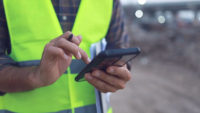Wearable Mobile Solutions to Improve EHS & Performance Management
In 2016, the National Institute for Occupational Safety and Health (NIOSH) empowered miners with a new wearable device according to Centers for Disease Control and Prevention. NIOSH researchers have documented that a continual personal dust monitor (CPDM), (which is a wearable device that monitors the amount of dust in the miner’s breathing) has created a 90% decrease in dangerous levels of dust for miners reducing pneumoconiosis (black lung). The CPDM monitors the wearer’s zone and is detected and updated in a digital readout.
Technology such as the CPDM monitor has potential to revolutionize all aspects of EHS and Job Safety processes. With the right tools and the possible ability to track things like heart rates, noise levels, ergonomics and air quality, technology can create a safer work environment for men and women in the field.
How?
Technology capabilities can be used by frontline workers to possibly receive cues about daily actions, hazardous situations and even provide the support of a dispatcher in the event it’s needed. For example, for an in-field worker stepping into a hazardous situation they may not recognize, having a dispatcher on call to see what the wearer is seeing is beneficial in informing the wearer how to best avoid dangerous and harmful conditions.
What’s the Outcome without Wearables?
NIOSH researches have further stated in the December 16 issue of CDC’s “Morbidity and Mortality Weekly Report” that, Miners who suffer from black lung experience lifelong and irreversible breathing problems that are often leading to premature death and alarmingly in severe cases, progressive massive fibrosis (PMF). As if that weren’t bad enough, the U.S. Department of Labor’s Black Lung Program has paid over 43 billion in compensation to sufferers since 1970 and over 289 million in 2015 alone.
Being a Connected Worker
Improvements on current technology will allow the device to determine the cause of an adverse scenario. In fact, activity tracking can improve a worker’s productivity by determining if a worker is even taking unnecessary steps to complete a task or if exertion is causing a rapid heart rate increase.
A variety of sensors like self-contained breathing apparatus, heart rate monitor, toxic gas monitor, an activity detection device and non-verbal gesture device can immediately signal if a dangerous situation is likely. Companies can then provide change within minutes to exposure.
Follow the Leaders
EHS leaders are now recognizing the positive outcomes that can come from revolutionizing job safety processes. In fact, wearables tie in with goals of most organizations today like:
- Ensuring safe, secure and reliable operations
- Delivering safe and effective products and services
- Increasing organizational effectiveness and compliance with applicable requirements
- Engaging internal and external stakeholders to work together
- Preventing and planning for incidents and events
- Preserving and transferring institutional knowledge
- Sustaining a license to operate
Getting Connected
Quality, Health, Safety, Risk and Environmental Management companies are benefitting from integrated and connected solutions that build control, improvements and visibility into standards with mobility in three steps.
Step one is to control. In order to build control, companies must first plan, track, initiate and collaborate. Step two is to improve. In order to improve they must manage change, mitigate risk and execute it effectively. Step three is to increase visibility through integration by recording, tracing, building reports and analyzing.
As most Environmental Health and Safety professionals know, incidents can occur daily. They happen in various levels and forms, such as injuries, chemical spills, illnesses and more but regardless of type it is most important to manage these incidents properly.
Taking Solutions Mobile
Having the ability to document all incidents and collect data is the best way to streamline the process of tracking and reporting on these safety incidents throughout the entire organization. Having a mobile platform enables users to work online or offline by syncing forms offline in the field and then re-syncing them within the enterprise system when ready. The data that’s recorded will then automatically appear in the enterprise solution. Working with mobility helps companies to keep on track whether they are out in the field or sitting at their desk.
Automated Solutions with Mobile Solutions Enable Users To:
Identify Risks
Risk Management allows an organization to manage and track all incidents that have taken place and provide visibility into data for everyone across the enterprise to see, regardless of their location. This is helpful, especially if there is more than one location as employees are able to delve deeper into information from location to location and make educated decisions on how to take action against potential incidents and adverse events.
Take Corrective Action (If necessary)
Corrective action is taken to another level when linked with Risk and EHS Management. It enables all events to be linked and filtered properly, rather than in the order of which they’ve entered the system. Meaning, whichever event is most critical will be handled first. Knowing the difference between a detrimental and non-detrimental event could be the difference between life and death. If used in the field, this can detect hazardous outcomes throughout a worker’s entire shift.
Report on Data
An organization with the ability to report on data has the ability to read into the tracking and trending of all incidents within the organization. Being able to pinpoint the exact location and cause of incidents allows users to apply corrective actions, if needed, immediately and ultimately reduce the risk associated with each occurrence.
Pulling data into reports of regulatory forms ensures the process of reporting on incidents is done quickly and effectively. With management across the organization and an effective reporting tool, organizations are able to proactively address incidents that occur and produce change effectively.
Integrating Wearable Devices with Mobility and EHS Management Processes
A wearable smart device that connects workers to industrial monitoring systems is said in a Honeywell and Intel report, to provide multiple functions. They keep workers safe and more productive. So, what’s the first step in implementation?
Plan
The first step would be to create a roadmap on how wearable devices fit into the company’s overall risk management process. Configure which processes are already being used, which events pose the highest risks to workers and what past injuries and illnesses have occurred which could have possible been prevented with wearable device monitoring.
Do
This will require leveraging data from an already built EHS Management System. As devices are available for monitoring toxic gas and rapid heart rate, it should also be considered how accurate the device may be. Determine what the alert will be when it needs calibration or battery replacement and how will it speak to your monitoring system.
Once this is prioritized, and it has been decided where to incorporate wearable devices for safety and risk mitigation, it is time to strategize for effective implementation. This can be done through planning with employees and ensuring it is well known within the Document Control system how the wearable device will be used and how data can be leveraged for operational excellence.
Employee training is an ideal requirement so that workers know when and how to use and adjust Personal Protective Equipment (PPE).
Check
After incorporating data on wearable devices, it is time to fit the actual device into your already built EHS process. Monitoring implementation effectiveness as well as generated data may be done through Audit and Reporting tools.
Audit Management will allow administrators to see whether workers are using wearables correctly and if they are using them properly. If not, it will be a good opportunity to figure out why and how to fix it. An issue can be something due to employee training, in which real-life situations aren’t matching up to training on the plant-floor. This is better to be addressed within an audit, rather than a real-life scenario.
Reporting is also a great benefit of wearable devices. It allows dispatchers the ability to generate in the field data that in field workers are immediately dealing with in the same view that would otherwise never be seen. This enables front-line workers to better analyze potentially high-risk scenarios or areas and act.
From an informational standpoint, implementation of wearable devices may require an adjustment period. From an exposure monitoring standpoint, the opportunities are endless as users can create—
- Dashboard alerts and alarms for when exposures reach critical levels
- Detailed analyses to determine the appropriate reaction or equipment change processes to reduce worker exposures
- Determine and pinpoint near-misses and generate more predictive data that help prevent injuries and illnesses
Wearables help workers stay safe and get the most out of their actions. With the proper amount of technology, event detection to monitoring data analysis along with planning and change management is possible.
Maintaining a high-level of safety within Environmental Health and Safety organizations requires the ability to proactively address all incidents that occur. Working to reduce job-related incidents will promote a safer workforce, while enabling compliance with regulatory industries.
Environmental Health and Safety Management intertwined with mobility and wearables helps manage the process of reducing job-related incidents while effectively reducing the chance of errors made.
Automation
Automating processes can be ideal for finding incidents, helping to manage them more efficiently and prevent them from recurring. The result of wearables helps to put users in control of situations they normally would not have control over. This creates a holistic system for addressing all incidents and reducing the number of safety incidents that occur as well as money spent as a result of adverse events.
Benefits of Mobile
Wearables help keep workers connected to industrial monitoring systems with location monitoring, activity detection, non-verbal gesture tracking, heart-rate monitoring and toxic gas monitoring.
Mobile devices transform the way an organization operates. It provides the ability to detect data in the field or in any location and sync the forms that are necessary by working offline in the field and then syncing to enterprise systems when ready, or automatically.
Communication is really what it’s all about. By increasing employee engagement inside of your four walls as well as out of the office, there is a better chance at an increased safety culture.
With an involved platform, a single holistic application allows companies real-time access to important data within solutions and the ability to search and filter records for better control and visibility into safety and compliance activities wherever they’re needed most by monitoring systems.
With all technologies integrated and connected users can expect a high-performance safety organization as well as:
- Enhanced worker safety
- Monitored worker fatigue and health risk assessment
- Intelligent sensor networks for hazard communications
- In-vehicle monitoring systems for safer driving behavior in fleets
- Unmanned aerial vehicles for industrial inspections and accident investigations
- Virtual reality technology for immersive safety training and feedback
- Augmented reality displays for enhanced job hazard warnings
- RFID tags for smarter chemical inventory tracking
- Online and offline-capable mobile apps for comprehensive safety observations and incident reports
- Intrinsically safe mobile devices for use in restricted areas
- Digital permit to work for industrial safety and operational excellence
Making the shift toward a proactive safety culture by focusing more on leading indicators, behaviors and results is best done through automation. With a fast-moving market, it is important to remember that it is not just about results, but rather it is about the safety of employees and the public. Having the ability to foresee a potential event or situation allows for the difference between planning actions or planning a reaction. Automated technologies in the form of management systems and wearables are helping to integrate people, processes and actions to create a healthy safety culture.


